Address any questions or comments regarding this newsletter to the individual authors listed after each article or to its editors, Nathan Johanning, 618-939-3434, njohann@illinois.edu or Bronwyn Aly 618-695-6060, baly@illinois.edu. The Illinois Fruit and Vegetable News is available on the web at: http://ipm.illinois.edu/ifvn/. To receive or be removed from email notification of new postings of this newsletter, contact Nathan Johanning or Bronwyn Aly at the phone numbers or email addresses above.
In This Issue:
Upcoming programs (listings for beginning and established growers)
News & Announcements (New Blog Starting in October, FSMA Produce Safety Rule Certification Training, IL Farmers Market Association Offering Several Education Opportunities this Fall)
Regional Reports (St. Louis metro east, SoSuCo (Matteson), central Illinois (Normal), southern Illinois (Murphysboro), Dixon Springs)
Upcoming programs
See the University of Illinois Extension Local Food Systems and Small Farms Team’s website at:
http://web.extension.illinois.edu/smallfarm/ and the calendar of events at http://web.extension.illinois.edu/units/calendar.cfm?UnitID=629.
- The Great Lakes Fruit, Vegetable & Farm Market Expo (GLEXPO) is returning to its traditional face-to-face format, and will be held December 7-9, 2021 at the DeVos Place in Grand Rapids, Michigan. Registration for the program itself will be coming at a later date, but you should make your room reservations now as hotels near the conference site tend to fill up quickly. Visit their website for additional details as they become available at https://glexpo.com/expo-schedule/ or visit their Facebook page at https://www.facebook.com/GLExpo/
- 2022 KY Fruit and Vegetable Conference will be held January 2-4, 2022 in Bowling Green, KY. Registration and conference information can be found at https://kyhortcouncil.org/2022-ky-fruit-vegetable-conference/
- 2022 Illinois Specialty Crops Conference is also returning to a face-to-face format January 5-7, 2022 at the Springfield Crowne Plaza. Our program team is well on their way to providing another great program, so we should have program details available in the coming months.
- Great Plains Grower School (Kansas, Missouri, Nebraska and Iowa) will be held January 7-8, 2022 in St. Joseph, MO. Registration and conference information can be found at https://www.greatplainsgrowersconference.org/
- Indiana HORT Conference and Expo will be held January 19-20, 2022 in Indianapolis, IN. Registration and conference information can be found at https://www.indianahortconference.org/
News & Announcements
New Blog Starting in October
The Local Food Systems and Small Farms team is excited to introduce our new blog “Local Foods, Local Farms, Local People.” These articles will feature a different local farmer or producer from around Illinois each month. Growers and producers will share their journeys, lessons, and successes with extension educators from all over the state. We hope to provide insight into local food production on Illinois farms, as well as lessons learned along the way.
Our first article will feature Jeremy Zorbist of Rock Creek Farms speaking with extension educator Nick Frillman about pumpkin seed production in Danvers, Illinois. Please keep an eye out for this article coming in October!
FSMA Produce Safety Rule Certification Training
What: FSMA Produce Safety Rule (PSR) Certification Training
When: November 4-5, 2021
Where: Online
Cost: $30 | Space is limited to 30 attendees! Registration will close Sunday, October 17
For more information and to register for the training visit https://thelandconnection.org/event/fsma-psr-training/
The course will provide a foundation of Good Agricultural Practices (GAPs) and co-management information, FSMA Produce Safety Rule requirements, and details on how to develop a farm food safety plan. Individuals who participate in this course are expected to gain a basic understanding of:
- Microorganisms relevant to produce safety and where they may be found on the farm
- How to identify microbial risks, practices that reduce risks, and how to begin implementing produce safety practices on the farm
- Parts of a farm food safety plan and how to begin writing one
- Requirements in the FSMA Produce Safety Rule and how to meet them.
After attending the entire course, participants will be eligible to receive a certificate from the Association of Food and Drug Officials (AFDO) that verifies they have completed the training course. To receive an AFDO certificate, a participant must be present for the entire training and submit the appropriate paperwork to their trainer at the end of the course.
IL Farmers Market Association Offering Several Education Opportunities This Fall
Just as a reminder, the Illinois Farmers Market Association provides information and guidance to farmers market managers as well as farmers market vendors. ILFMA is another resource that lends support to the fruit and vegetable industry in Illinois. Visit https://www.ilfma.org/events/ to learn more about upcoming educational opportunities this fall, including Home to Market Act-Changes to the Cottage Food Law webinar and Illinois Certified Farmers Market Manager Course 2021/2022.
Regional Reports
From St. Louis metro east… A touch of fall is in the air with field corn in harvest and beans not far behind. Halloween pumpkin sales have begun as well as haunted hayrides and corn mazes. Demand for apple cider is strong. Peach and blackberry harvest is finished. Apple harvest is ongoing. Honeycrisp harvest is finished, Gala is winding down, and current harvest is on Jonagold, Red Delicious and Golden Delicious. The pumpkin crop looks good. Rainfall has not been lacking, and in some cases has made disease management challenging in some cultivars due to ponding and poor conditions for fungicide application. Plasticulture strawberries have been planted and are looking good.
Heads up! A 1-day Cider HACCP (Hazard Analysis Critical Control Point) workshop will be held at the 2022 Illinois Specialty Crops Conference on January 5. This workshop will focus on IL HACCP plan compliance and will include the following components.
- Basics of hazards and risks associated with juice products
- Why do you need a Food Safety Plan
- HACCP primer
- HACCP plan writing activities (come prepared with your product and process description)
Space will be limited, so book your spot as soon as registration becomes available at https://www.specialtygrowers.org/iscc2022
Elizabeth Wahle (618-344-4230; wahle@illinois.edu)
From the South Suburban Cook Urban Agriculture Demonstration and Research site (SoSuCo) in Matteson, IL (Cook County)…
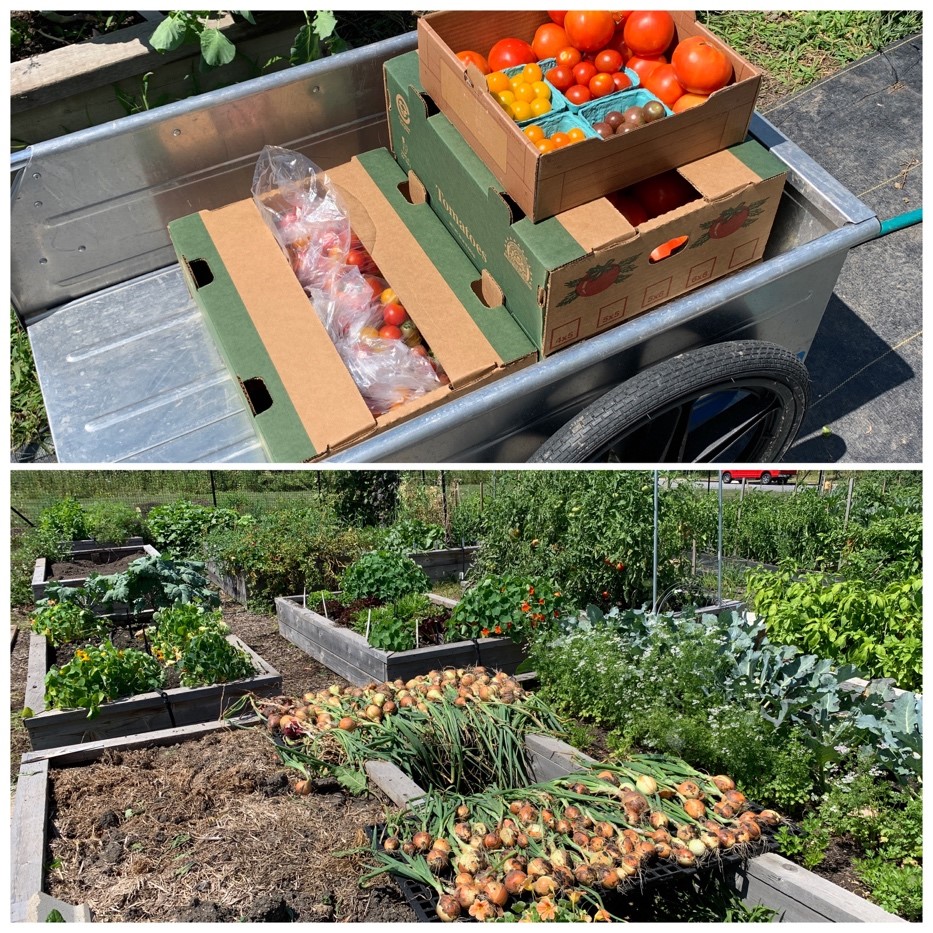
With the Autumn Equinox on the horizon, the days are shortening, the summer fruiting crops are slowing down, and the sun is headed south. The 2021 season at SoSuCo has been a busy and successful one! The very first full season of production at the site! While the final totals have not been tallied, we have likely brought more than 2,000 pounds of produce to South Cook County food pantries. A final report of the season will come in the next newsletter. As we prepare to transition the outdoor beds for overwintering, planting will continue for the season extension structures at the site. This will include cold hardy vegetable trials in the high tunnel, overwintered crops in low tunnels outdoors, and yet to be constructed mini-tunnels on some of the outdoor raised beds.
The 2022 Heritage Tomato High Tunnel Variety trial is also winding to a close. Multiple heritage tomatoe varieties (hybrid heirloom varieties) were tested to evaluated their performance in the high tunnel at SoSuCo. These heirlooms are crossed with hybrid varieiteis that have known resistance to common soil borne tomato diseases and airborne transmitted diseases such as leaf mold. The data from this project will include total fruit number per plant, average yield per plant, as well as other qualitative information about the varieties. This data will be compared to similar trials being conducted at the Sustainable Student Farm on the main campus of the University of Illinois Urbana-Champaign.

The high tunnel at SoSuCo is a fixed non-movable structure. While this makes for a structurally sound tunnel, it also makes transtioning between summer fruiting crops to winter crops a challenege. The tunnels I formerly managed at the Sustainable Student Farm are movable. Meaning, I can establish the winter cold hardy crops outdoors and move the high tunnel structure over the top of the plantings for protection when the temperatures begin to drop. In fixed tunnels with summer fruiting crops, a decision has to be made before the end of September as to when to remove the summer plants and begin planting the winter ones. It is critical to take advantage of the September and early October day length in order to establish crops for overwintering in the tunnel. Since this is my first time using a fixed tunnel, I failed to anticipate how much moisture was being distributed via the drip irrigation system during the summer months. A soil moisture sensor or tensiometer would have helped me manage the irrigation controller better to prevent this. Needless to say, the beds are extremely wet and drying out very slowly. In order to create conditions for planting, I have improvised with a no-till planting technique.
In the pictures to the left, I have lightly broadforked the wet bed to allow for drainage and break up any compaction. I was careful not to mix the layers or break up chunks as this could damage the soil structure when working it this wet. You would never rototill a soil this wet! Then, in the front portion of the bed I have laid down some moistened cardboard in an area that had a bit of weed pressure and where I will set lettuce transplants directly into. Finally, I brought in a 4” layer of well broken down leaf compost that will sit directly on top of the bed. It is into this thin layer of compost that I will direct seed and set plants into. Of course, I will run a quick soil nitrate test to see if I need to amend the compost at all before planting. With winter crops you want to be careful not to add too much nitrogen as winter greens grown in low light conditions tend to accumulate excessive nitrate levels.
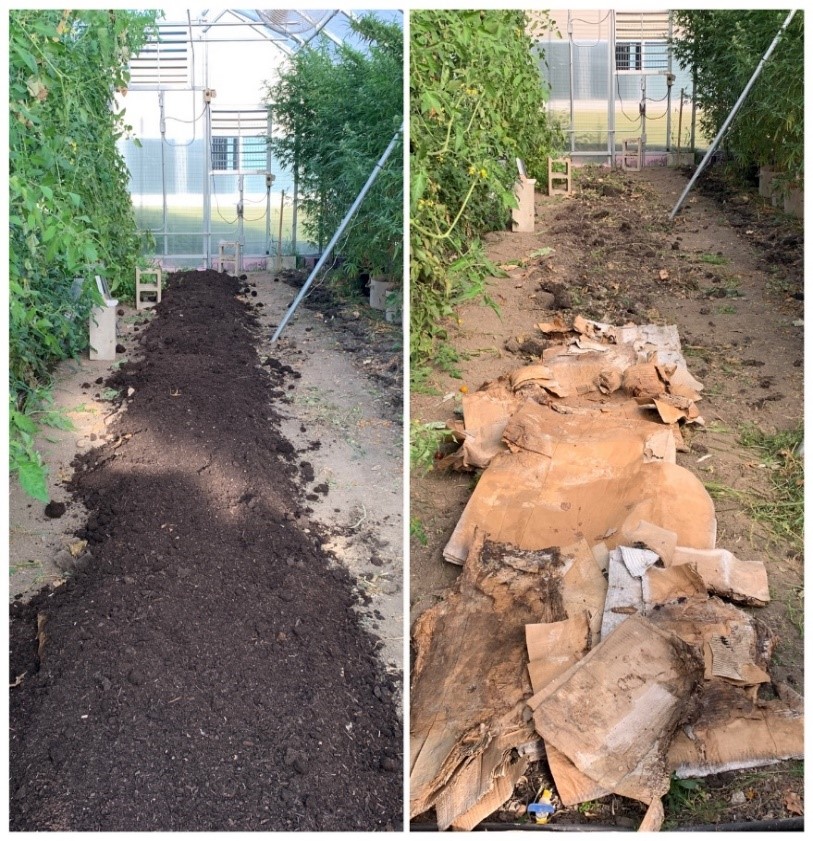
Zachary Grant (708-449-4320; zgrant2@illinois.edu)
From central Illinois (Normal)…For those who are unfamiliar, the Unity Community Center Production and Demo Garden is located in northern Normal, IL, and is part of an Extension-owned property. Topping out at just over 2500 ft2, it is small yet mighty! On about half of that garden, or just over 1200 ft2, my garden assistant and I grew over 1000 lbs. of produce for donation to the surrounding area this year; the local zip code was identified in the town’s last food security census as “food insecure”.
More than half of our 1000 lbs. of giveaway produce this year were our tomatoes: “Big Beef”, and “Marbonne” slicing tomatoes, as well as a Roma variety – “Paisano”. Besides that, we had a healthy amount of super-hot, hot and not-so-hot peppers, eggplant, okra, and tomatillos. It was an up-and-down growing season this year, especially for solanaceous vegetables. I’ll let the meteorologists tell me whether it was an officially “normal” year or not, but to me, it felt “weird”.
The reader will notice that we did our growing of all that produce on only half the garden; why is that they ask? It is because I decided to rejuvenate the soil of the other half all year this year with no-till cover crops. Maybe I was spoiled last year working on a high SOM silt-loam in Oregon, but in my opinion, the garden soil was compacted and low in SOM, to name a few issues…
In spring, the garden received a clover-oats-field pea regimen, then in summer, cowpea and Japanese millet. On September 6 a few weeks ago, I planted my cover crops mix for fall, winter and early spring regrowth not just on the “rejuvenation”, but also on the vegetable-growing side of the garden (after cutting out all my plants and removing landscape fabric, yard staples and everything else). The mix contains 12 cover crop species, including several legumes, grasses and brassicas. However, this time my approach to no-till cover crop establishment was different. Yes, this is where it gets interesting…
In both spring and summer, I established our cover crops like this: 1.5X the recommended seeding rate, broadcast on bare ground (spring, after tillage) or on top of/underneath a maturing cover crop (summer). During the spring establishment, I watered the oats-field pea-clover seed a lot, on bare ground. During the summer establishment, after broadcasting seed into the spring stand, I terminated by weed whacking with a three-point blade and laid the spring cover residue down on top of the summer seeds, then watered.
I took a different approach for our fall/winter/spring cover crop mix; I seeded the ground AFTER terminating the summer cover crop (on top of the residue) on August 20, and after ripping out vegetable plants September 3 (on bare ground). What the two sides have in common going into winter is that this time, I applied a 1” layer of compost on top of the seeds, for increased seed-soil contact, and then covered the compost with about 1-2” of oat straw, bought locally, for increased soil moisture retention. I would rate my spring, summer and fall/winter/spring cover crop establishment/stand quality with the following grades: C, C, A. Note: the picture shows the difference of seeding date on stand establishment
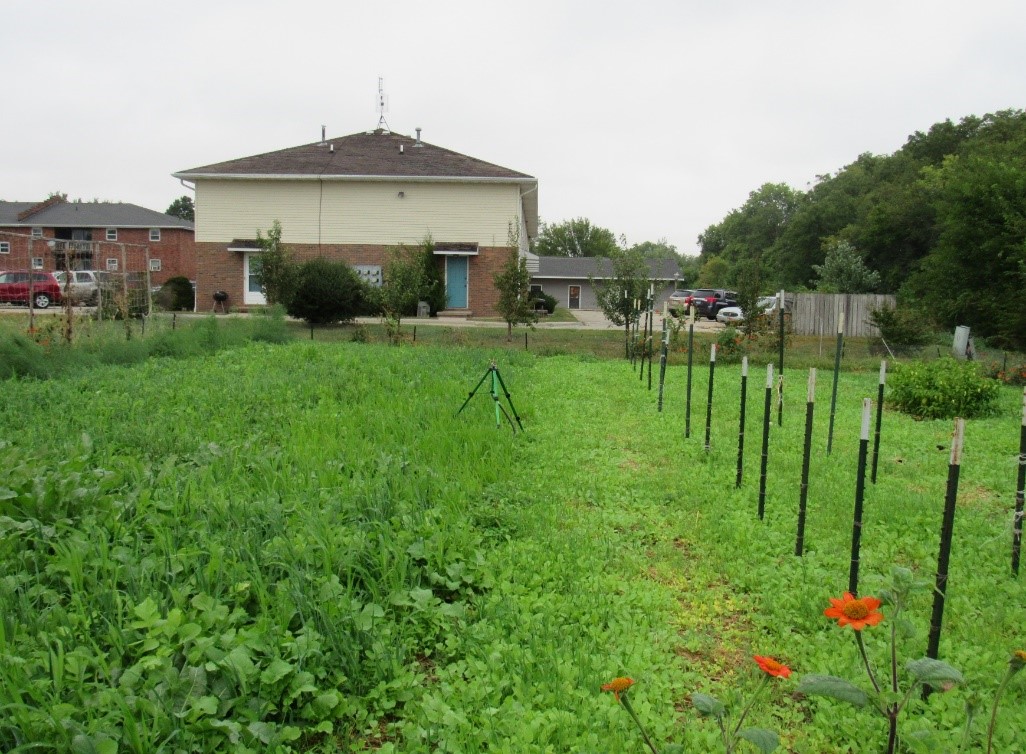
I’m thinking of terminating on May 1, for maximum cover crop regrowth, by weed-whacking and then mowing on the lowest setting, then silage tarping to kill the hard-to-kill grasses. Pictured is the establishing cover crop, as of last week Friday. On the rejuvenation side of the garden, I took a soil core last week and noticed that compared to the spring, it is darker, more crumbly or friable, and smells alive! Good signs… Stay tuned for no-till cover crop class announcements, available locally!
Unity Community Center Production and Demo Garden, Normal IL; left side is “rejuventation” side, right side was vegetable growing side. Photo by Nick Frillman.
Nick Frillman (309-663-8306; frillma2@illinois.edu)
From southern Illinois (Murphysboro)… The first day of fall arrived in southern Illinois with beautiful cool weather. Night temperatures have been in the low 50’s, reaching the mid-70’s during the day. Here at the Jackson County office we have been cleaning up field trials, preparing the high tunnel for the cool season crops, and general fall grounds clean up. We have also been harvesting many types of decorative gourds including snake gourds and even a few loofa gourds. The gourd tunnel has made harvest very easy this year, although a few larger gourds have grown around the panels.
The high tunnel is currently being prepared for several varieties of colored carrots, lettuce, and swiss chard. We are also planning to do some cool season greens in the raised beds this fall. We will be using a small backyard greenhouse over one of the raised beds again this year.
Overall the summer growing season can be counted a success and I am excited to get the fall 2021 growing season underway!

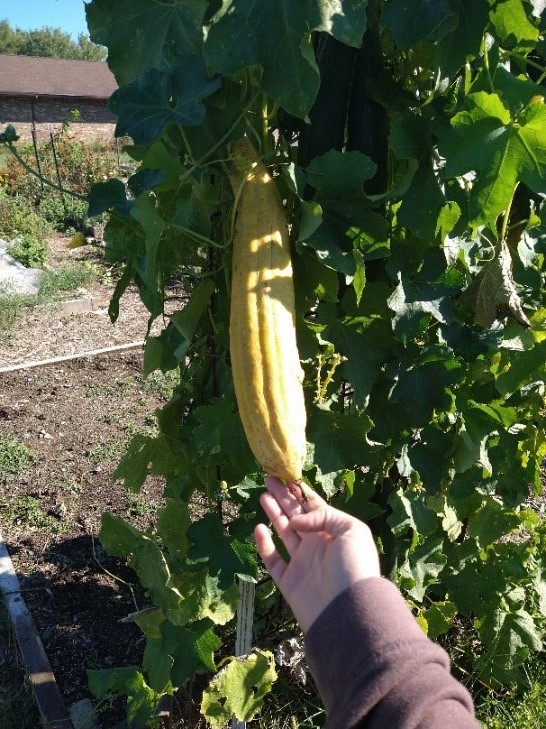
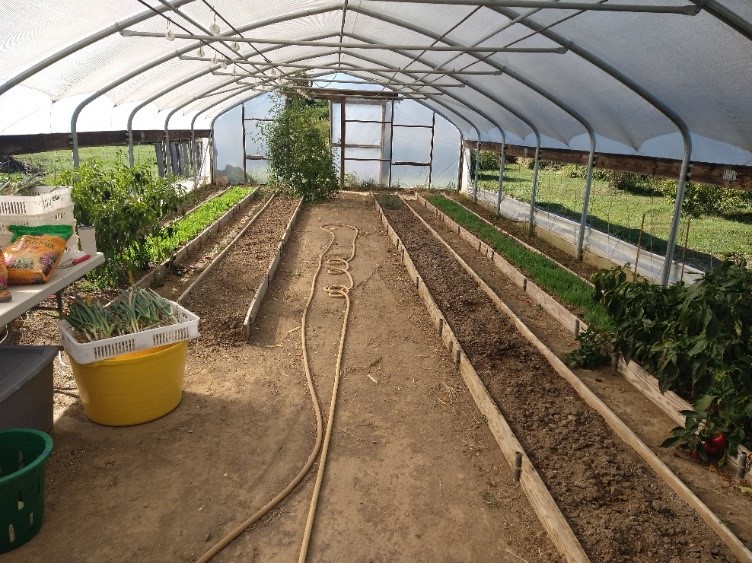
Bottom Left Photo: My face after I think I’ve picked all the tomatoes, and someone says “there is still another row to harvest”. Photos by K. Bell.
Katie Bell (618-687-1727; klbell@illinois.edu)
From Dixon Springs Ag Center…We couldn’t ask for a better first day of Fall. We received a much needed 1” rain yesterday and the temperatures for the next few days will be in the upper 60s to low 70s and in the lower 50s at night.
Several growers in the area were able to get beds pulls and strawberry plug plants transplanted by mid-September in their strawberry plasticulture production fields, and the rain this week will help settle those transplants in nicely. As those plants grow through the fall, growers will need to remember to keep the electric fence charged to keep the deer out; scout for any late season insect or disease problems and be ready with a spray if needed before row covers get applied in late late fall or early winter; and clip or pinch runners so that the plant focuses its energy on crown growth and branch crown development.
We have stopped collecting data on the tomato fertilty project and just harvesting the few remaining fruit as they ripen. In the next couple of weeks, we will begin to remove spent plant material from the tunnels. It is important to remove as much plant debris as possible from any growing areas, field or tunnels, to help lower the incidence of disease pathogen carryover into the next season. Within the high tunnels, we will also make sure any weeds are removed to hopefully eliminate areas for insect pests to overwinter. Any T-posts, stakes, or reuseable materials will be sanitized before putting away for the winter, making them ready to go quickly next spring.
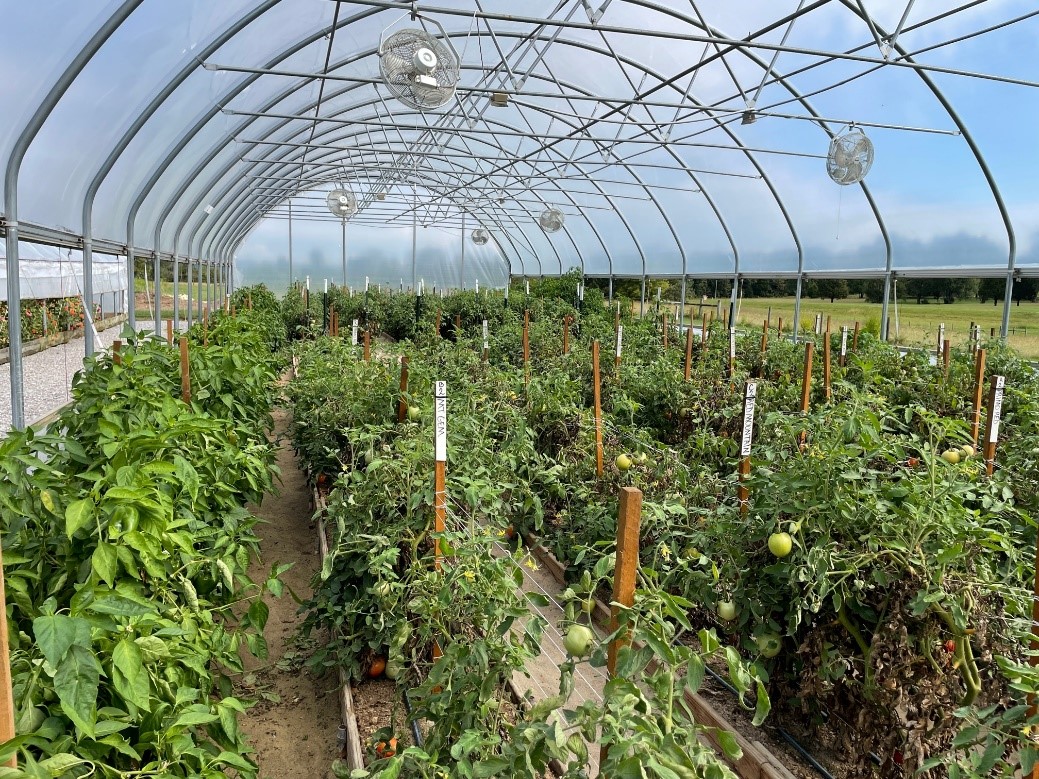
Aphids and worms still seem to be the biggest insect pests across all of the tunnels. The thrips pressure that had been so high most of the season within the hydroponic tunnel seems to have gone in the complete opposite direction. Very few, if any, thrips have been observed in the cucumber flowers and I am hopeful that the biological control predator insects utilized within the hydroponic tunnel to control the thrips have finally gotten the upper hand.
Tomato fertilty project at DSAC coming to an end. Plant material and stakes will be removed soon in order to clean and sanitize tunnel and materials before the next planting season. Photo by B. Aly.
Our hydroponic strawberries are still producing, although I believe they have slowed down from a month ago. We have submitted our application to the Illinois Herb Assocation to become a designated Certified Herb garden site within the hydroponic tunnel at DSAC. One of the plant species that could be included in the certified herb garden was elderberry so this spring we set out two elderberry plants in our beto buckets filled with perlite. These two plants are continuing to flower and set berries, well past the normal time for elderberries in a typical outdoor growing situation in southern Illinois. Plant growth in high tunnels never ceases to amaze me!
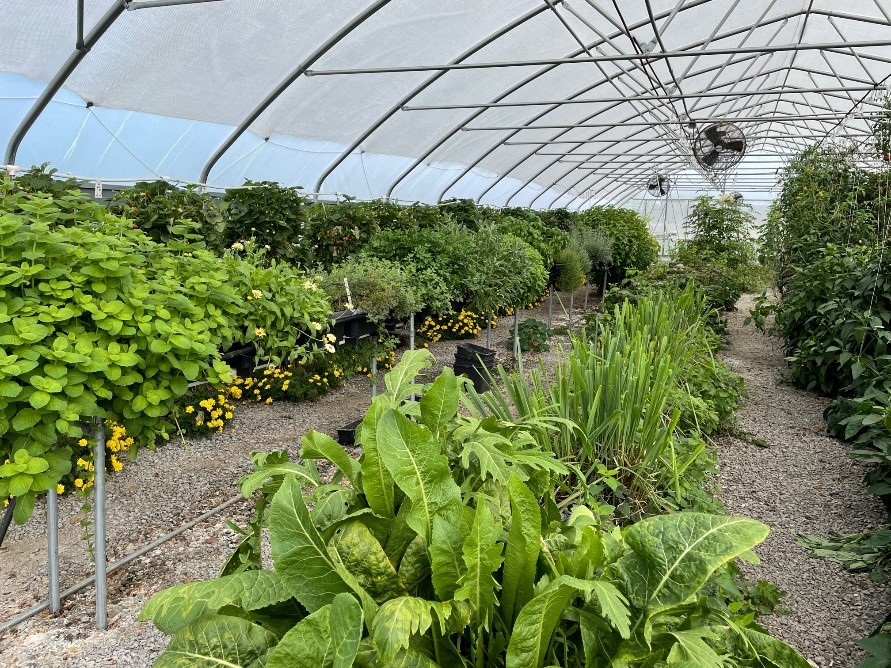
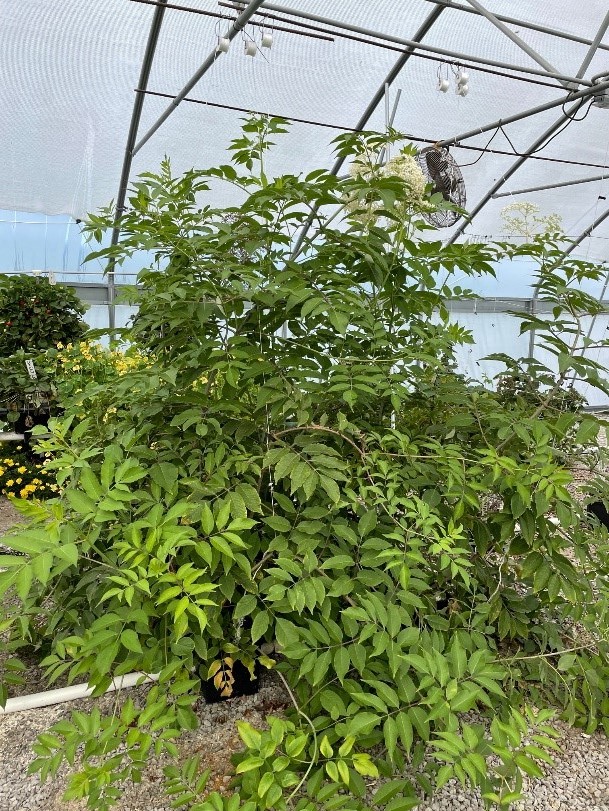
Top: Area in hydroponic tunnel at DSAC that will hopefully receive designation as a Certified Herb Garden from the Illinois Herb Association. Right: Elderberry plants being grown hydroponically at DSAC and are still flowering and setting fruit. Photos by B. Aly
Bronwyn Aly (618-382-2662; baly@illinois.edu)
Less Seriously
Less Seriously… It’s that time of year again!!!! Excited families all across the state are lining up to buy your pumpkins, mums, straw, ornamental corn, etc. to create the most wonderous fall decorations. Thank you to all the growers who provide the products that allow us to create great memories!

University of Illinois Extension Specialists in Fruit and Vegetable Production & Pest Management
Extension Educators – Local Food Systems and Small Farms |
||
Bronwyn Aly, Gallatin, Hamilton, Hardin, Pope, Saline, and White counties |
618-382-2662 |
|
Katie Bell, Franklin, Jackson, Perry, Randolph, & Williamson counties |
618-687-1727 |
|
Sarah Farley, Lake & McHenry counties |
847-223-8627 |
|
Nick Frillman, Woodford, Livingston, & McLean counties |
309-663-8306 |
|
Laurie George, Bond, Clinton, Jefferson, Marion, & Washington counties |
618-548-1446 |
|
Zachary Grant, Cook County | 708-679-6889 | |
Doug Gucker, DeWitt, Macon, and Piatt counties |
217-877-6042 |
|
Erin Harper, Champaign, Ford, Iroquois, and Vermillion counties |
217-333-7672 |
|
Grace Margherio, Jackie Joyner-Kersee Center, St. Clair County |
217-244-3547 |
|
Grant McCarty, Jo Daviess, Stephenson, and Winnebago counties |
815-235-4125 |
|
Katie Parker, Adams, Brown, Hancock, Pike and Schuyler counties |
217-223-8380 |
|
Kathryn Pereira, Cook County |
773-233-2900 |
|
James Theuri, Grundy, Kankakee, and Will counties |
815-933-8337 |
|
Extension Educators – Horticulture |
||
Chris Enroth, Henderson, Knox, McDonough, and Warren counties |
309-837-3939 |
|
Richard Hentschel, DuPage, Kane, and Kendall counties |
630-584-6166 |
|
Andrew Holsinger, Christian, Jersey, Macoupin, & Montgomery counties |
217-532-3941 |
|
Extension Educators - Commercial Agriculture |
||
Elizabeth Wahle, Fruit & Vegetable Production |
618-344-4230 |
|
Nathan Johanning, Madison, Monroe & St. Clair counties |
618-939-3434 |
|
Campus-based Extension Specialists |
||
Kacie Athey, Entomology |
217-244-9916 |
|
Mohammad Babadoost, Plant Pathology |
217-333-1523 |
|